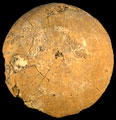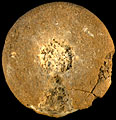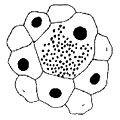| Species Included |
-
C. macropygus Agassiz, 1837; Hauterivian-Aptian, western Europe [includes Holectypus neocomiensis Gras, 1848].
-
C. almeidae (Rey, 1966); U Valanginian - L. Hauterivian, Porugal
-
C. neocomiensis Gras, 1850; Aptian-Cenomanian, western Europe, North Africa and Brazil.
-
C. castilloi (Cotteau, 1890); U. Albian, Mexico. USA [includes C. charltoni (Cragin, 1893)]
-
C. cenomanensis (Cotteau & Triger, 1861; Cenomanian, Europe, North Africa, Middle East
-
C. corona (Gauthier, 1889); Upper Senonian, Tunisia.
-
C. crassus (Cotteau, 1861); Cenomanian of France.
-
C. inflatus (Cotteau & Gauthier, 1894); Upper Senonian, Iran.
-
C. larteti (Cotteau, 1869); Cenomanian, Middle East, North Africa [includes Holectypus chauveneti Peron & Gauthier, 1878]
-
C. planatus (Roemer, 1852); Albian, USA [includes Holectypus engerrandi Lambert, 1927; Holectypus adkinsi Smiser, 1936]
-
C. pulvinatus (Desor, 1847); Cenomanian of North Africa, Middle East and the Canary Islands [includes Holectypus cortesei Checchia-Rispoli, 1920].
-
C. excisus Desor, 1847; Cenomanian, France, Spain, North Africa, Sinai and Syria.
-
C. serialis (Agassiz & Desor, 1847); Coniacian-Santonian of France, North Africa and the Middle East.
-
C. turonensis (Agassiz & Desor, 1847); Coniacian of France, Santonian of France, Belgium, North Africa and the Middle East.
-
C. sphaeroides (Stoliczka, 1873); Maastrichtian of Iran, Turkey, The Arabian Peninsula, Madagascar.
-
C. subcrassus (Peron & Gauthier, 1881); Campanian - Maastrichtian, North Africa, Pakistan, southern India and Madagascar.
-
C. nachtigali (Krumbeck, 1906); Maastrichtian of Spain, North Africa and the Arabian Peninsula.
-
C. trechmani (Hawkins, 1913); Late Cretaceous, late Campanian-early Maastrichtian, Cuba. [= C. cubae Hawkins, 1913].
-
C. castilloi (Cotteau, 1890); Albian of Mexico and Southern USA.
|
| Remarks |
This group evolved directly from Holectypus with the acquisition of a fifth gonopore. It is relatively common in shallow nearshore habitats throughout the Cretaceous. In Temnholectypus the periproct is separated from the peristome by more than two interambulacral plates.
C. macrostomus (Engel, 1964) (Maastrichtian of Limburg, the Netherlands) is based on a 3 mm individual that is a juvenile without gonopores.
Discoidea philocrania Lambert, 1933, p. 16, pl. 2, figs 8-10 is a poorly known form from the mid upper Senonian (?Campanian) of Antonibe, Madagascar that may also belong here. It is based on a small individual (7 mm diameter) but with 5 open gonopores.
Pomel, A. 1883. Classification méthodique et genera des Échinides vivante et fossiles. Thèses présentées a la Faculté des Sciences de Paris pour obtenir le Grade de Docteur ès Sciences Naturelles, 503, 131 pp. Aldolphe Jourdan, Alger.
Smith, A. B. & Jeffery, C. H. 2000. Maastrichtian and Palaeocene echinoids: a key to world faunas. Special Papers in Palaeontology 63, 1-404.
|



